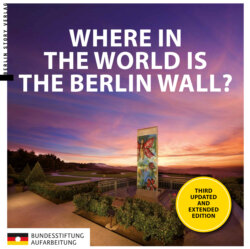Читать книгу Where in the World is the Berlin Wall? - Группа авторов - Страница 41
На сайте Литреса книга снята с продажи.
ODENSE DENMARK Location: Sculpture Garden Odense, Galerie Jens Galschiøt, Banevänget 22
ОглавлениеModel of the Wall memorial by Jens Galschiøt
© Jens Galschiøt
Two pieces of Wall, each approximately two metres tall, complete with protruding rusty steel cables, can be found in Danish architect Jens Galschiøt’s garden. The plan was originally to consolidate the pieces into a memorial, but this never actually happened. The internationally renowned sculptor was so awestruck by the images of the Fall of the Wall on 9th November 1989 that he was keen to create a sculpture that commemorated these historical events. Berlin was the focal-point of the world and he considered it important to capture the euphoric mood in a memorial.
Galschiøt contacted both mayors of the divided city and requested they send him a few pieces of the Wall. The two mayors considered his request with open minds. However, the GDR government had decided in December that the remains of the former border should be sold at as high a price as possible, and Galschiøt was referred to the West Berlin company, “LeLé Berlin Wall Verkaufs- und Wirtschaftswerbung GmbH”, which had been commissioned to market it. The costforthe pieces he requested was between 40,000 and 90,000 Deutsche Mark – a price he could not afford. He contacted the two mayors again and finally reached an agreement to be given two pieces of the so-called “Hinterlandmauer”, free of charge.
The pieces of Wall were handed over in Berlin on 18th June 1990. Galschiøt used this opportunity to publicly present the plans for his memorial: on an area of 25 × 8 metres, people, with only half a body, move towards the Wall and only after passing through the Wall do they become full-bodied and disperse in all directions. He returned to his studio in Denmark to begin work on this symbolic idea.
By now, the initial euphoria evoked by the Fall of the Wall was ebbing away. It was proving increasingly difficult to find sponsors for his ambitious vision, and the plans had to be scaled down. But nobody wanted to erect even the smaller version in Berlin. Galschiøt then got in touch with Willy Brandt in October 1990, hoping to inject new life into the project. The former Mayor of Berlin supported the project, but was unable to provide materials or funding. In the meantime, the authorities of the reunited city were busy wiping the Wall from the face of the city landscape. By the end of 1990, the Wall had been dismantled. There were debates about what to do with the few remaining parts and where a memorial should be built.
Artist Jens Galschiøt with his pieces of Wall, Odense
© Jens Galschiøt
Galschiøt’s plans were met with less and less interest. The major corporations who had secured land on the former death strip at Potsdamer Platz, did not want to erect the memorial either. In 1992, in a final attempt to gain political support, the artist finally sent miniature models of his memorial plans to all parties of the Berlin state parliament. Only the Mauer Museum “Haus am Checkpoint Charlie” agreed to at least show the model in its exhibition. Two years later, when plans to erect his work at one of the last remaining watch towers at Schlesischer Busch on the border between Treptow and Kreuzberg also failed, Galschiøt eventually gave up his pursuit.
Alongside Wall segments, that are slowly being weathered in the open-air, a few sculptures remain in the artist’s nearby studio, waiting and hoping that the memorial may still actually be built.
